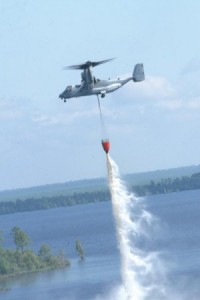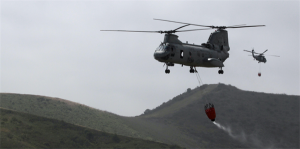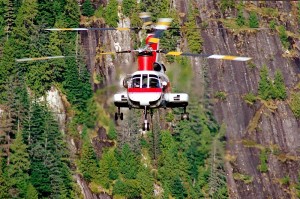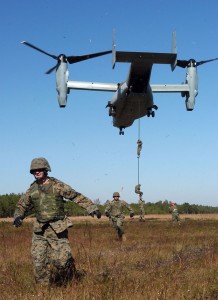 As California strives to fully contain the Rim Fire–now the 4th largest wildfire in California history–it might be edifying to revisit the progress MV-22 has made in integrating with likely Homeland Security/Disaster Response/Humanitarian Missions on the homefront. We will start with firefighting–can the Osprey fight fires?
As California strives to fully contain the Rim Fire–now the 4th largest wildfire in California history–it might be edifying to revisit the progress MV-22 has made in integrating with likely Homeland Security/Disaster Response/Humanitarian Missions on the homefront. We will start with firefighting–can the Osprey fight fires?
Asking the question:
A few years ago, I wrote an Op-Ed marking the MV-22’s arrival in California, urging more work be done to prepare the Osprey to support disaster response. In it, I made this comment:
Designed for the Cold War, before Homeland Security emerged as a Defense Department priority, the Osprey risks leaving gritty first responders in the lurch, wishing the Marine Corps had passed up the Osprey for a few extra “old school” helicopters.
Take wildfire fighting. At first glance, the Osprey seems a firefighter’s friend, outclassing every Marine Corps helicopter currently certified to drop water upon fires. Boasting a planned external hauling capacity of up to 15,000 pounds, the MV-22 can, in theory, carry a lot of water to the fire line.
Yet the Osprey has never bombed a single fire.
Camp Pendleton —- the sprawling Southern California Marine Corps base —- is regularly hit by wildfires. But the new helicopter-plane has gone oddly AWOL in California’s firefight.
After more than two decades of development, the failure to evaluate the Osprey for firefighting and other homeland support roles is inexplicable.
The Marine Corps responded:
Six months after the Op-ed went to press, the USMC started evaluating the ability of the MV-22 to handle “Bambi Buckets”, the water-carrying sacks helicopters use to “bomb” wildfires.
The first tests went forward on 9 July 2010. From the Rotovue:
The Osprey lifted and hauled a 900-gallon water container, commonly referred to as a Bambi Bucket. The collapsible helibucket is used extensively in aerial firefighting. It scooped water from a reservoir and then released it, simulating a water drop over a forest or brush fire.
Although the test went well, the use of the Osprey to fight fires is still in the earliest stages of experimentation, said Capt. Justin D. McKinney, VMX-22 operational and test director.
 That was followed up in 2011 with this wonderful powerpoint detailing additional tests/trials.
That was followed up in 2011 with this wonderful powerpoint detailing additional tests/trials.
From the presentation, it looks like the MV-22, if needed, is set to use the SEI Industries 7590 Bucket–a 900-gallon bucket that weighs 7900 lbs. when full. However, while tethered to the Bucket, the Osprey flight envelope looks very similar to traditional helicopters–So while the Osprey’s speed might be helpful in getting to the site, when carrying a bucket, the Osprey performance is indistinguishable from every other rotary-wing fire-bomber on the fire line.
Is the MV-22 suitable as a water-bomber?
The MV-22 certainly won’t do much water-bombing in the United States. It simply is not competitive enough–unless the Osprey’s operational envelope evolves (i.e. the speed “with bucket” increases) to the point where the tilt-rotor can offer more mobility than conventional rotary-wing competitors, cash-strapped municipalities will stick with other, less costly platforms.
To be truly viable, the Osprey’s operational (per hour) cost must come down. In comparison to other helos in the inventory, the Osprey’s operational cost cannot be justified except as a last resort. Look at the numbers. For water drops, the per-hour operational cost of the Osprey is still too high in comparison to its conventional counterparts–the CV-22 costs $83,256 dollars an hour while the HH-60G Pave Hawk costs $24,475. (We have no numbers for the MV-22 variant or for Navy platforms.)
Eliminate the time spent in transit to the fire, and that’s more than three drops for the price of one.
A look the military competition:
The Osprey does not bring much additional capability to the water-bombing side of the equation. Again, look at the numbers. According Calfire, the Sikorsky Firehawk, the civil variant of the Blackhawk, can carry a bucket capable of delivering 1,000 gallons of water per trip; a manned Kamen K-Max can carry 700 gallons; a National Guard UH-60 Blackhawk can carry 780 gallons; a National Guard CH-47 can carry 2,000 gallons. On the Naval side of the roster, the CH-53E can carry 2,000 gallons, while the CH-46 comes up in the rear with only 224 gallons (about 2,000 lbs total, which is odd, given that an old Marine Corps fact-file rates the CH-46 as capable of carrying 4,000 lbs as an external load).
Our trusty USMC beancounters are, at this very moment, touting the fact that the Osprey can drop four times the water in one trip as the CH-46, which makes the operational cost look favorable, etc., etc…–but we will talk more about this later when we examine the Environmental Impact Statements the USMC produced to support MV-22 basing in Japan (Sadly, the “B Team” is still producing MV-22 EIS documents).
Why do civilian CH-46s carry so much more?
 In examining the firefighting arsenal, the Navy CH-46E seems somewhat…constrained in terms of lift. Columbia Helicopters, an outfit based near Portland Oregon, fly civil variants of the CH-46 and CH-47. When firefighting, those two helicopters respectively wield 1300 gallon and a 2650 gallon SEI Torrentula bambi buckets when on the fire line–markedly more than the higher-horsepower military model. Here’s the Columbia Helicopter website:
In examining the firefighting arsenal, the Navy CH-46E seems somewhat…constrained in terms of lift. Columbia Helicopters, an outfit based near Portland Oregon, fly civil variants of the CH-46 and CH-47. When firefighting, those two helicopters respectively wield 1300 gallon and a 2650 gallon SEI Torrentula bambi buckets when on the fire line–markedly more than the higher-horsepower military model. Here’s the Columbia Helicopter website:
Columbia’s current heavy-lift helicopter fleet consists of Columbia Vertol 107-II and Columbia Model 234 Chinook tandem rotor helicopters. Water buckets are matched to each helicopters’ external lift capabilities. The Vertol 107-II carries an 1,300-gallon bucket and the larger Columbia Model 234 Chinook deploys a 2,650-gallon bucket.
The Calfire handbook on firefighting aircraft disagrees a bit, and suggests 1,100 gallons for the civil CH-46 and 3,000 gallons for the civl CH-47. But regardless of the data sources, if you look at the SEI chart, the CH-46 civil variant is out there hauling between 10,000 to 11,500 lbs. per trip. And we’re not just talking about fighting fires at sea level, either.
The USN CH-46E certainly has some extra goodies bolted on the airframe, but I still don’t see how the lower-horsepower variants (ex-Japanese or ex-Swedish military airframes ) used by Columbia Helicopters can carry 8,000 lbs more than the higher-horsepower US variant CH-46.
It is enough to wonder…Is the USMC’s interesting accounting at work?
 At home, the Osprey needs to focus on its strengths:
At home, the Osprey needs to focus on its strengths:
So, where does that leave the Osprey? It is pretty clear that until operating costs decline, the Osprey will have a small presence at the fire-line. That said, the Osprey can still offer 1) speed and 2) range. So while the Osprey is not particularly well-suited for service on the fire-line’s “last mile”, it does have an opportunity to serve in a rapid-response or fast logistical support role. That is where the Osprey can win.
Water-drops are good, and the MV-22 has demonstrated that capability. But rather than continue going head-to-head with the conventional rotary-wing competition in a bambi-bucket challenge, the Osprey could garner great headlines (and probably do pretty good service) by, say, working out a scheme to reduce the response time for elite wild-fire fighters–smokejumpers or hotshot teams. If the Osprey can help get “boots on the ground” faster, reducing the time it takes to initially attack wildfires AND (possibly) reducing the cost of initial attacks (what’s more expensive–maintaining jump-ready firefighters or exchanging the jump requirement for, say, a mere requirement to fast-rope out the back of the Osprey?), the Osprey might be quite useful.
And then there’s logistics. If the Osprey is still a hangar queen, then the solution is to keep it close to the hangar. Water-bombing often puts helicopters right on the front line, operating from less-than-ideal forward sites–something I suspect MV-22 maintainers (and USMC beancounters) do not want. On the other hand, logistic “support runs” from a defined base (say Sacramento) to defined and prepped expeditionary “pads” near the fire site saves hours and hours of transit time for needed parts, people and supplies.
If the MV-22 Program Office wants to try and pitch the MV-22 as a next-gen Navy COD or C-2A Greyhound replacement, then wildfire resupply might be a useful means to do this (if anything, it’s an interesting means to build Congressional support!).
What’s the wider impact?
The Homeland Defense mission matters. I’ll discuss this more later, but the ability to contribute at home is a big sales point for some international customers. In the ongoing effort to sell the Osprey to Japan, the MV-22’s new firefighting capability is a major headline.
That said, any effort to find homeland security work at home should avoid pressing the Osprey into roles where it is unsuited to serve. The Osprey, at this point, is not a tool for the “last mile” in HA/DR emergencies. This is not a tool to serve in the front-line grind of a water-bombing campaign. This is not a tool for front-line urban post-earthquake SAR, either (We will talk more about this, too, as MV-22 rotor wash in a debris field is not my idea of a good time).
At this point, the MV-22 is solely a tool to bridge distance quickly. At home, Osprey-boosters should focus on moving people and small items quickly from a logistical hub to a relatively clean expeditionary “pad” near a disaster. The Osprey won’t be in the thick of things, and MV-22 may not attract dramatic news coverage–pulling kids from rooftops, dropping tons of water on a big fire or anything like that, but behind-the-scenes logistics is important in helping enable other platforms to enjoy those great moments–and it is where the MV-22 can make a real difference.
